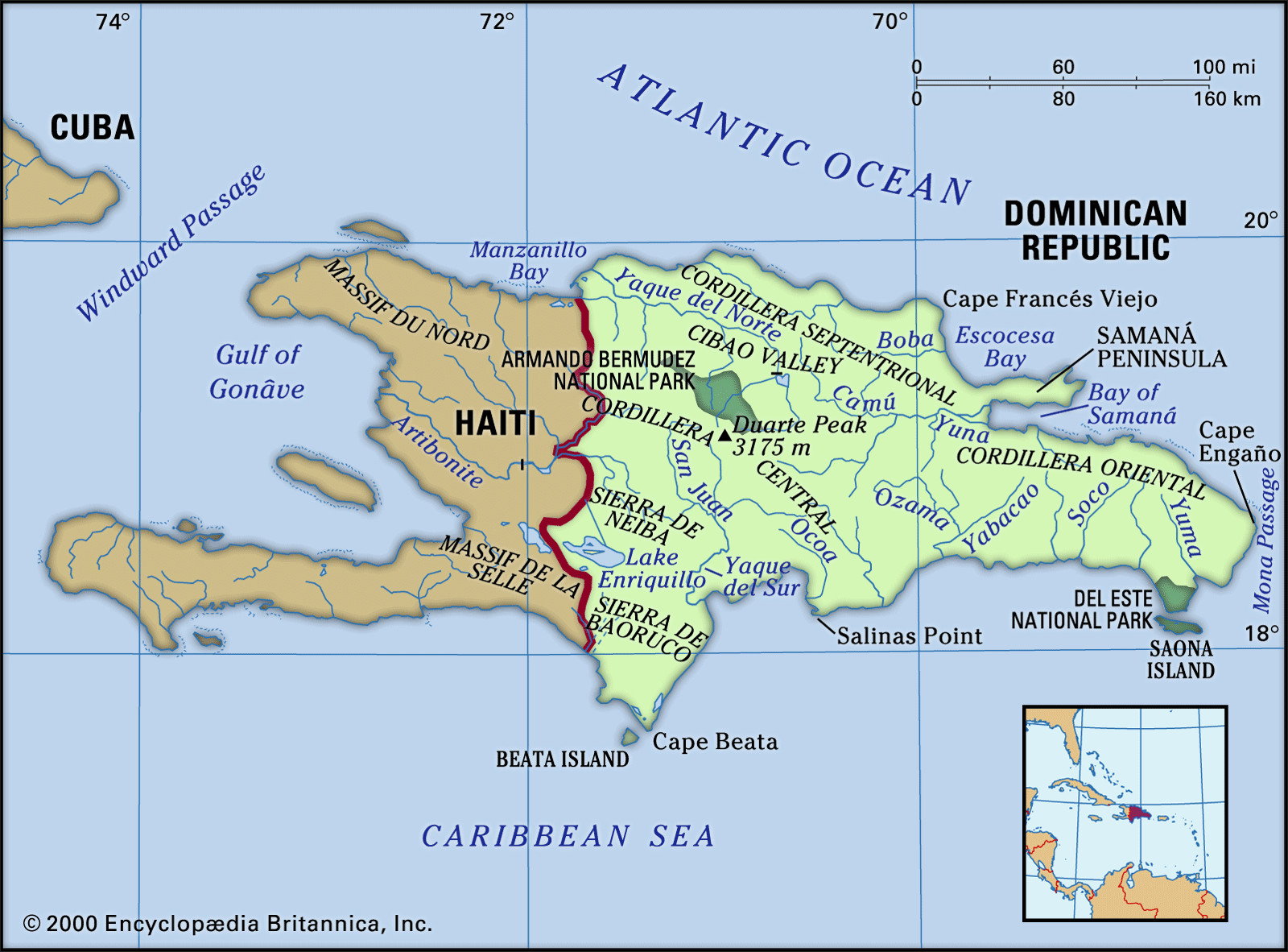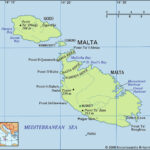Nestled in the heart of the Caribbean, the Dominican Republic is a nation of striking contrasts and captivating beauty. But Where Is Dominican Republic exactly? This English-speaking guide will delve into the geographical heart of this island nation, exploring its diverse landscapes, climate, and unique biodiversity, offering a richer understanding than a simple pinpoint on a map.
Location of the Dominican Republic: A Caribbean Gem
The Dominican Republic is situated in the West Indies, sharing the island of Hispaniola with Haiti. Positioned between the Atlantic Ocean to the north and the Caribbean Sea to the south, its strategic location places it east of Cuba and west of Puerto Rico. This places the Dominican Republic firmly within the Caribbean archipelago, a region celebrated for its tropical allure and vibrant culture.
 Physical features of the Dominican Republic showcasing its location in the Caribbean islands
Physical features of the Dominican Republic showcasing its location in the Caribbean islands
Diverse Terrain: Relief, Drainage, and Soils
The geography of the Dominican Republic is remarkably diverse, boasting both the highest and lowest points in the West Indies. Its terrain is characterized by a series of mountain ranges and fertile valleys that predominantly run from northwest to southeast, shaping the landscape and influencing its ecosystems.
The northern region is defined by the Cordillera Septentrional, a mountain range that rises dramatically from a narrow coastal plain. This plain is traversed by short rivers like the Balabonico and Yasica. To the south of these mountains lies the extensive Cibao Valley, a vital agricultural region stretching from Manzanillo Bay to the Samaná Peninsula and the Bay of Samaná. This valley is nourished by two significant river systems: the Yaque del Norte, flowing northwest, and the Camu-Yuna system, heading eastward, both contributing to the valley’s rich soils.
Dominating the island’s interior is the Cordillera Central, known as Massif du Nord in Haiti. This imposing mountain range is the most rugged feature of the Dominican Republic, with an average crest elevation of 6,000 feet. It culminates in Duarte Peak, the Caribbean’s highest point at 10,417 feet. Other notable peaks include Yaque, La Rucilla, Bandera, and Mijo. The northern slopes of the Cordillera Central are drained by tributaries of the Yaque del Norte, while the southern flanks feed the Yaque del Sur system, along with the Ocoa and Nizao rivers. The San Juan River, a key tributary of the Yaque del Sur, is central to the fertile San Juan Valley, which connects to Haiti’s Central Plateau via the upper Artibonite River valley.
South of the San Juan Valley, the Sierra de Neiba range rises, corresponding to Haiti’s Matheux and Trou d’Eau mountains, with peaks reaching approximately 7,200 feet. Water from this range flows towards the Caribbean via the Yaque del Sur system and inland to Lake Enriquillo, a saline lake. Lake Enriquillo is the Dominican Republic’s largest natural lake, and remarkably, its surface sits at 144 feet below sea level, the lowest point in the West Indies. Further south, the Sierra de Baoruco (Bahoruco) range, known as Massif de la Selle in Haiti, overlooks Cape Beata and the arid southwestern plain, including the Pedernales region.
In the east, the Cordillera Oriental forms a less rugged spine, separating a narrow northern coastal plain from wider southern lowlands. This southern belt is crucial for sugarcane cultivation. Rivers in this region, including the Ozama (flowing through Santo Domingo), Macorís, Soco, Chavón, and Yuma, all drain into the Caribbean Sea.
The most fertile soils are alluvial, found in the valleys of the Yaque del Norte, Yuna, San Juan, and Yaque del Sur rivers, as well as the Ozama and smaller southeastern rivers. Mountain slopes typically have poorer soils, often covered by forests and grasslands. Unproductive soils are limited, largely found around Lake Enriquillo due to salt deposits.
Climate: A Tropical Escape
The Dominican Republic enjoys a moderate tropical climate, tempered by elevation and the consistent northeast trade winds from the Atlantic. The average annual temperature is a pleasant 77 °F (25 °C), varying from 69 °F (21 °C) in the Cordillera Central to 82 °F (28 °C) on the coasts. Temperatures rarely exceed 90 °F (32 °C), and freezing temperatures are nonexistent.
Rainfall is heaviest in the northeastern mountains, the windward side of the island, exceeding 100 inches annually. As the trade winds move across the country, they release moisture on mountain slopes, leading to drier conditions in the western and southwestern valleys near Haiti, which receive less than 30 inches of rain. The northwestern and southeastern extremes are also relatively arid. The Dominican Republic is within the path of tropical storms and hurricanes, particularly between August and October, originating in the mid-Atlantic and southeastern Caribbean. Devastating hurricanes have impacted the country in past decades, highlighting the region’s vulnerability to these weather events.
Flora and Fauna: Rich Biodiversity
The Dominican Republic boasts more extensive vegetation cover compared to Haiti. Mountainous areas remain largely forested with pines and tropical hardwoods, although lower slopes have suffered deforestation for charcoal and timber. Drier regions are dominated by shrubs and scrub, while rainforests thrive in areas with higher rainfall. Royal palms are ubiquitous throughout the landscape. Agriculture has significantly altered natural vegetation, especially in fertile valleys and lower mountain slopes. Mangrove swamps fringe some coastal areas, contrasting with the extensive sandy beaches, particularly along the northern coast.
Wild animal populations are not abundant. Introduced species like cattle and goats have roamed wild for centuries. Alligators inhabit areas near the Yaque river mouths and Lake Enriquillo. A diverse array of birdlife, including ducks, are present and hunted. The surrounding waters, especially coral reefs, are rich in fish and shellfish.
Conclusion: Discovering the Dominican Republic
To answer definitively ” where is Dominican Republic?”, it’s more than just a geographical coordinate. It’s an island nation in the Caribbean, a land of towering mountains, fertile valleys, and sun-kissed coasts. Its location in the West Indies blesses it with a tropical climate and diverse ecosystems, making it a captivating destination for travelers and a fascinating subject for geographical study. The Dominican Republic’s unique location and varied landscape contribute to its rich cultural and natural heritage, making it a truly special place in the Caribbean.

